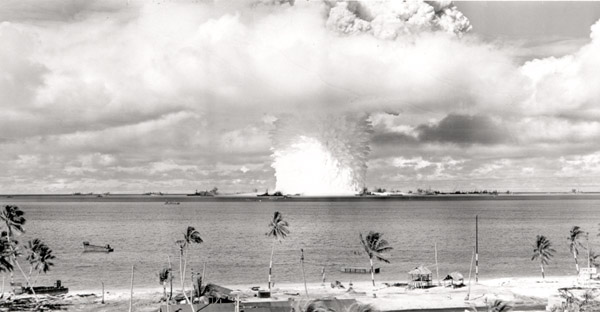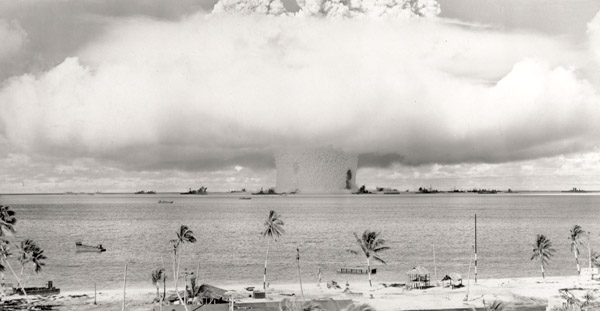These three photographs show the development of the familiar mushroom cloud of an atomic explosion. 750 cameras were brought to Bikini to record the explosions. Visible to the right of the water column are the Nagato (a captured Japanese battleship) and the USS Nevada (a survivor of Pearl Harbor). More ships were sunk during Test BAKER then in Test ABLE. Those that survived the explosion were later sunk as target vessels or scuttled in the Pacific.
The American Philosophical Society houses several collections that focus on the development of nuclear energy and atomic weapons. The Bikini Test images are from the papers of Edward Uhler Condon, who was associated with the atomic bomb project as associate director of the secret Los Alamos Scientific Laboratory (1943), and later as head of the theoretical physics division at E. O. Lawrence's Radiation Laboratory. He later served as advisor to Senator Brien McMahon, Chairman of the Senate special committee on atomic energy, and as director of the National Bureau of Standards. Dr. Condon was elected to the American Philosophical Society in 1949.
Two additional collections of note are the Henry DeWolf Smyth Papers and the Stanislaw Ulam Papers. Both Smyth and Ulam worked on the Manhattan Project during the Second World War. Dr. Smyth supervised fission-related research at Princeton University, and was associate director of the Metallurgical Laboratory in Chicago. He is widely known for his publication Atomic Energy for Military Purposes, also known as the "Smyth Report," which was published at the request of General Leslie Groves, and released to the public three days after the destruction of Nagasaki. Dr. Ulam went to work on the atomic bomb project at Los Alamos National Laboratory in 1943. As a mathematician, he was instrumental in the technical developments of thermonuclear weapons, but is also remembered for contributions to many fields, including set theory, topology, mathematical logic, and number theory. Both Drs. Smyth and Ulam were members of the American Philosophical Society, elected in 1947 and 1967 respectively.



